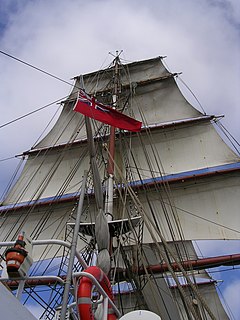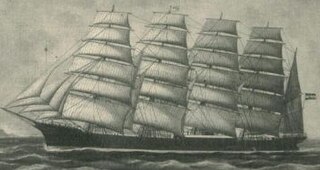
A sailing ship is a sea-going vessel that uses sails mounted on masts to harness the power of wind and propel the vessel. There is a variety of sail plans that propel sailing ships, employing square-rigged or fore-and-aft sails. Some ships carry square sails on each mast—the brig and full-rigged ship, said to be "ship-rigged" when there are three or more masts. Others carry only fore-and-aft sails on each mast—schooners. Still others employ a combination of square and fore-and aft sails, including the barque, barquentine, and brigantine. Sailing ships developed differently in Asia, which produced the junk and dhow—vessels that incorporated innovations absent in European ships of the time. Technically in the Age of Sail a ship was a specific type of vessel, with a bowsprit and three masts, each of which consists of a lower, top, and topgallant mast.

A sail plan is a description of the specific ways that a sailing craft is rigged, as discussed below. Also, the term “sail plan” is a graphic depiction of the arrangement of the sails for a given sailing craft.

A brigantine is a two-masted sailing vessel with a fully square rigged foremast and at least two sails on the main mast: a square topsail and a gaff sail mainsail. The main mast is the second and taller of the two masts.

A brig is a sailing vessel with two square-rigged masts. During the Age of Sail, brigs were seen as fast and maneuverable and were used as both naval warships and merchant vessels. They were especially popular in the 18th and early 19th centuries. Brigs fell out of use with the arrival of the steam ship because they required a relatively large crew for their small size and were difficult to sail into the wind. Their rigging differs from that of a brigantine which has a gaff-rigged mainsail, while a brig has a square mainsail with an additional gaff-rigged spanker behind the mainsail.

A barque, barc, or bark is a type of sailing vessel with three or more masts having the fore- and mainmasts rigged square and only the mizzen rigged fore and aft. Sometimes, the mizzen is only partly fore-and-aft rigged, bearing a square-rigged sail above.

Galleons were large, multi-decked sailing ships first used as armed cargo carriers by European states from the 16th to 18th centuries during the age of sail and were the principal fleet units drafted for use as warships until the Anglo-Dutch Wars of the mid-1600s. Galleons generally carried three or more masts with a lateen fore-and-aft rig on the rear masts, were carvel built with a prominent squared off raised stern, and used square-rigged sail plans on their fore-mast and main-masts.

A tall ship is a large, traditionally-rigged sailing vessel. Popular modern tall ship rigs include topsail schooners, brigantines, brigs and barques. "Tall ship" can also be defined more specifically by an organization, such as for a race or festival.

A cutter is generally a small to medium-sized vessel, depending on its role and definition. Historically, it was a smallish single-masted, decked sailcraft designed for speed rather than capacity. As such, it was gaff-rigged, with two or more headsails and often a bowsprit of some length, with a mast sometimes set farther back than on a sloop. While historically a workboat, as used by harbor pilots, the military, and privateers, sailing cutters today are most commonly fore-and-aft rigged private yachts.

A barquentine or schooner barque is a sailing vessel with three or more masts; with a square rigged foremast and fore-and-aft rigged main, mizzen and any other masts.

A lateen or latin-rig is a triangular sail set on a long yard mounted at an angle on the mast, and running in a fore-and-aft direction.

The mast of a sailing vessel is a tall spar, or arrangement of spars, erected more or less vertically on the centre-line of a ship or boat. Its purposes include carrying sails, spars, and derricks, and giving necessary height to a navigation light, look-out position, signal yard, control position, radio aerial or signal lamp. Large ships have several masts, with the size and configuration depending on the style of ship. Nearly all sailing masts are guyed.

A yard is a spar on a mast from which sails are set. It may be constructed of timber or steel or from more modern materials like aluminium or carbon fibre. Although some types of fore and aft rigs have yards, the term is usually used to describe the horizontal spars used on square rigged sails. In addition, for some decades after square sails were generally dispensed with, some yards were retained for deploying wireless (radio) aerials and signal flags.

Square rig is a generic type of sail and rigging arrangement in which the primary driving sails are carried on horizontal spars which are perpendicular, or square, to the keel of the vessel and to the masts. These spars are called yards and their tips, beyond the last stay, are called the yardarms. A ship mainly rigged so is called a square-rigger.

A full-rigged ship or fully rigged ship is a sailing vessel's sail plan with three or more masts, all of them square-rigged. A full-rigged ship is said to have a ship rig or be ship-rigged.

A jackass-barque, sometimes spelled jackass bark, is a sailing ship with three masts, of which the foremast is square-rigged and the main is partially square-rigged and partially fore-and-aft rigged (course). The mizzen mast is fore-and-aft rigged.

A skysail is the uppermost sail in many old square-rigged sail-plans. It was also on the royal mast above the royal sail. It was typically used in light winds.

The tallship Søren Larsen is a brigantine built in 1949 in Nykøbing Mors, Denmark. Her current homeport is Sydney, Australia.

James Baines was a passenger clipper ship completely constructed of timber in the 1850s and launched on 25 July 1854 from the East Boston shipyard of the famous ship builder Donald McKay in the United States for the Black Ball Line of James Baines & Co., Liverpool. The clipper was one of the few known larger sailing ships rigged with a moonsail.

Potosi was a five-masted steel barque built in 1895 by Joh. C. Tecklenborg ship yard in Geestemünde, Germany, for the sailing ship company F. Laeisz as a trading vessel. As its shipping route was between Germany and Chile, it was designed to be capable of withstanding the rough weather encountered around Cape Horn.

Southern Swan is a traditional Baltic trader, currently rigged as a three-masted barquentine. She is typical of coastal trading ships from the era 1840s to 1940s.





















